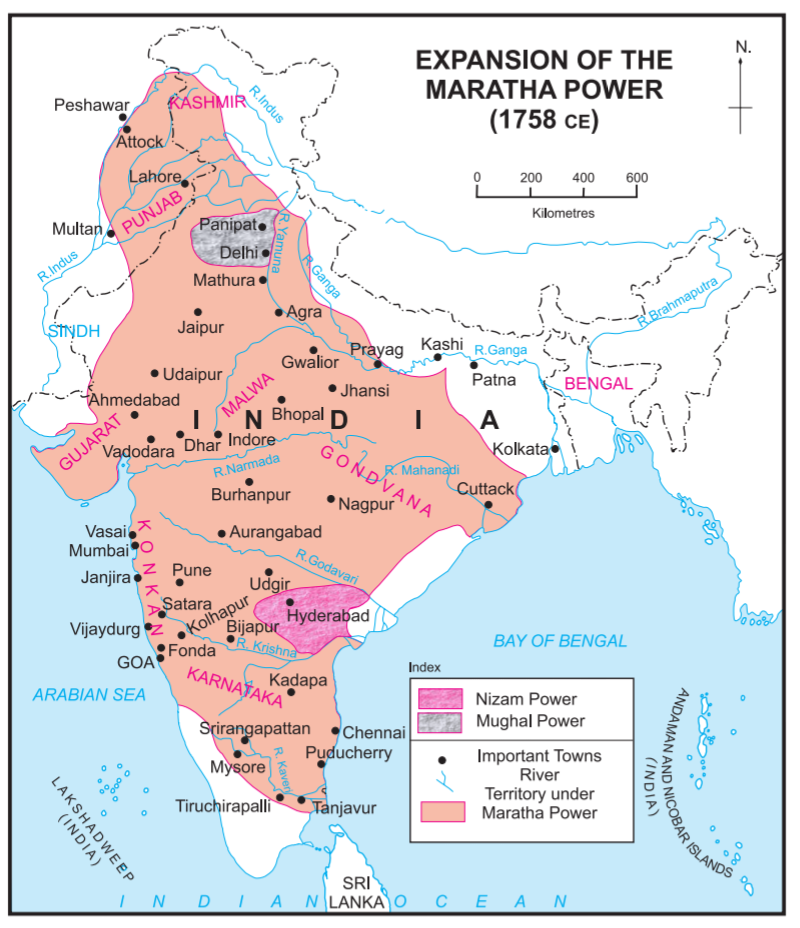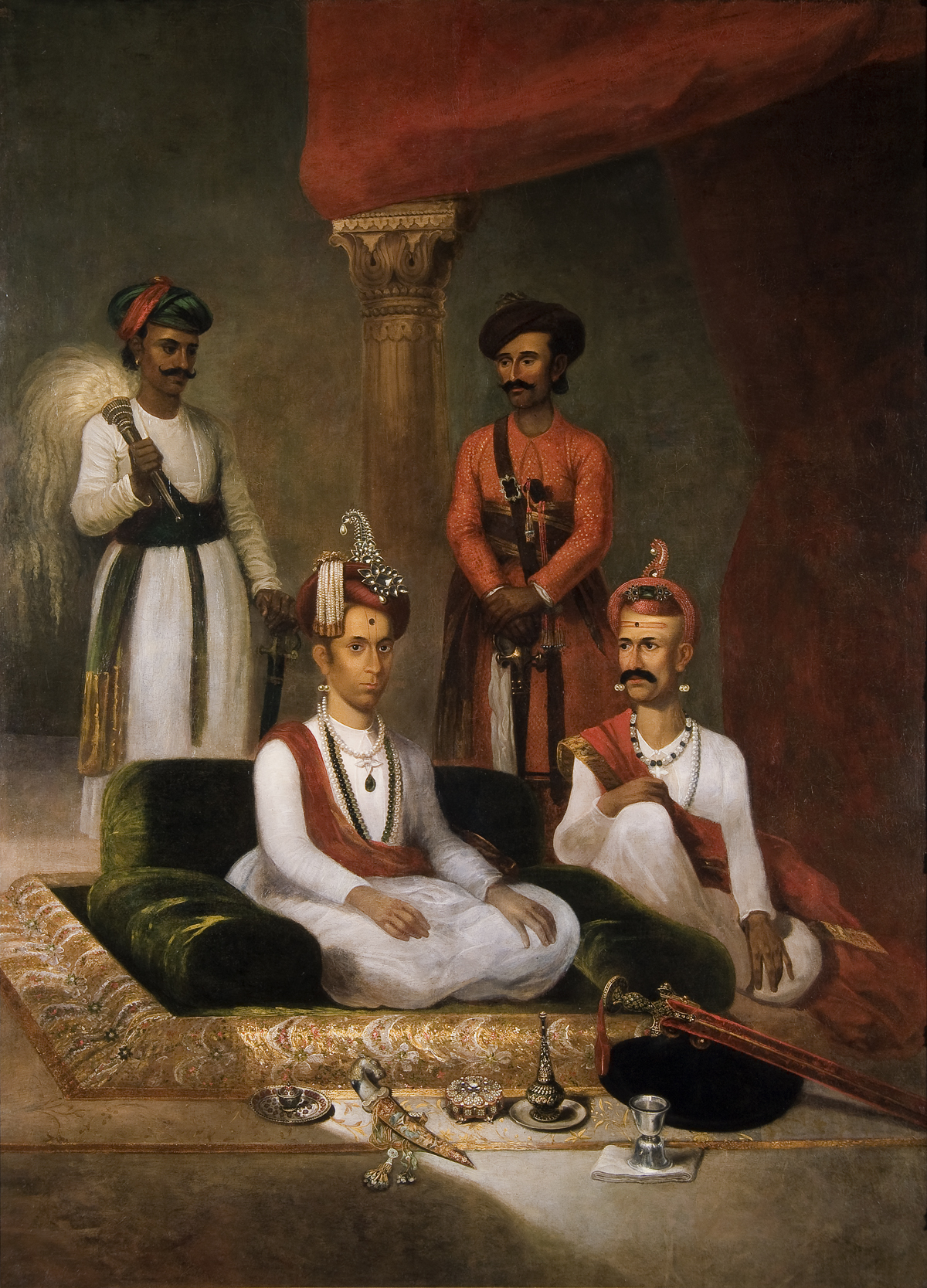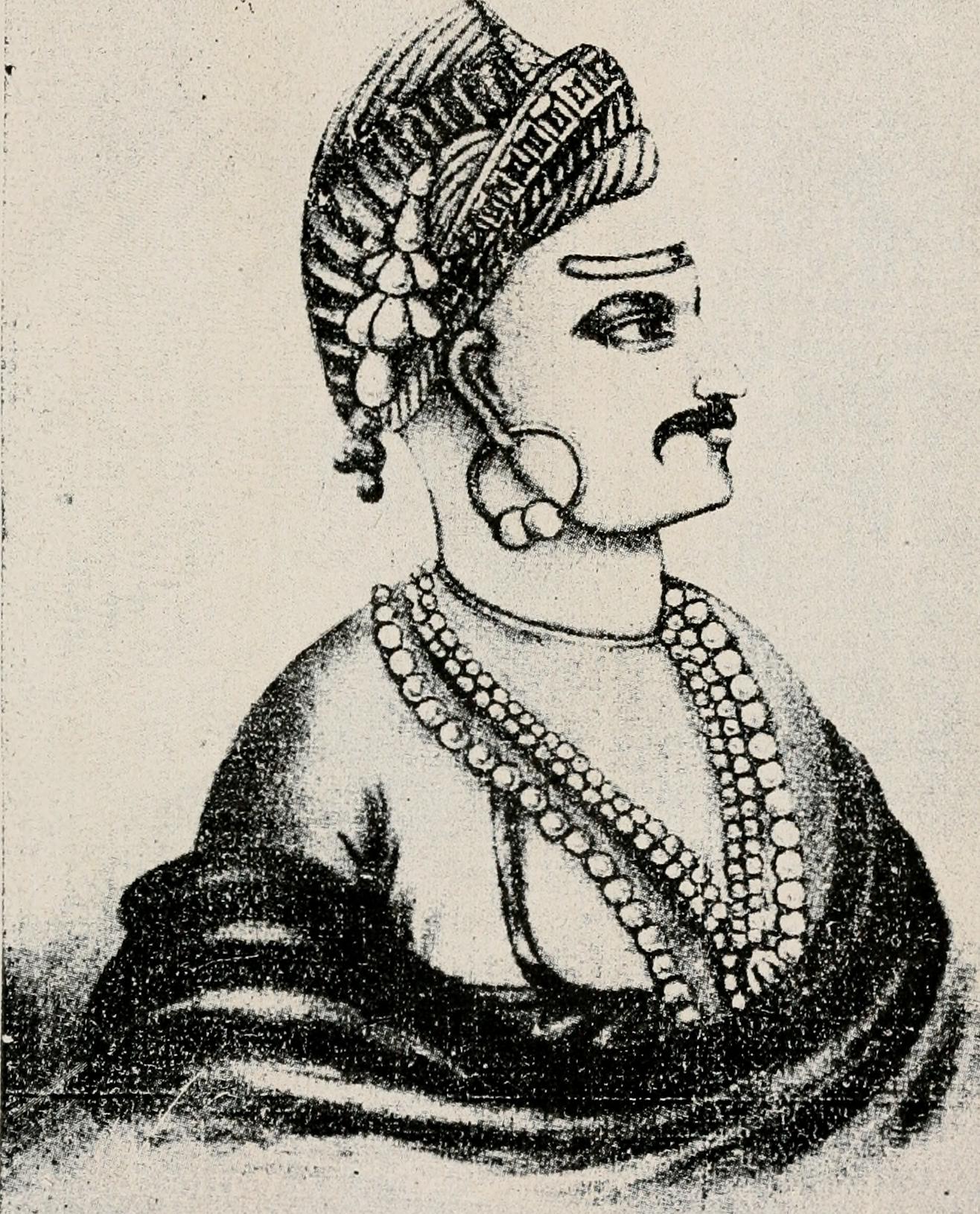|
Raghunathrao
Raghunathrao Bhat (a.k.a. Ragho Ballal or Ragho Bharari) (18 August 1734 – 11 December 1783) was the 11th Peshwa of the Maratha Empire for a brief period from 1773 to 1774. He was known among the Hindus for his extremely successful North-western campaign of 1757-58 and for his works to liberate the Hindu holy places of Kashi and Ayodhya. Early life Raghunathrao Bhat, also known as "Raghoba", "Raghoba Dada" and "Ragho Bharari," was the younger brother of Nanasaheb Peshwa. His father was Peshwa Bajirao I & mother was Kashibai. Raghunathrao was born in Mahuli near Satara on 8 December 1734. Much of his childhood was spent in Satara. A small time after his birth, his step-mother, Mastani gave birth to his brother, Krishna Rao, also named Shamsher Bahadur I Maratha conquests In his early years he fought with great success in the north. His expedition during 1753–1755 was concluded by an advantageous treaty with the Jats. Raghunathrao imprisoned Mughal Emperor Ahmad Shah ... [...More Info...] [...Related Items...] OR: [Wikipedia] [Google] [Baidu] |
Narayanrao
Narayanrao Bhat (10 August 1755 – 30 August 1773) was the 10th Peshwa of the Maratha Confederacy from November 1772 until his assassination in August 1773. He married Gangabai Sathe who later gave birth to Sawai Madhavrao. Early life Narayanrao Bhat was born 10 August 1755. He was the third and youngest son of Balaji Baji Rao (also known as Nana Saheb) and his wife Gopikabai. He received a conventional education in reading, writing and arithmetic and possessed a functional understanding of Sanskrit scriptures. He was married to Gangabai Sathe on 18 April 1763 before his eighth birthday. Gangabai was born in Kelashi village and belonged to Sathe family . Her father's name is not known, but Keshav Vinayak Sathe was the family head. Sathe's were the dashagranthi brahmins and were serving as priests of Kelashi's Mahalakshmi. Ruins of Gangabai's house are still present in Kelshi village near a small Datta Mandir. He was very close to Parvatibai, the widow of Sadashivrao, w ... [...More Info...] [...Related Items...] OR: [Wikipedia] [Google] [Baidu] |
Anandibai
Anandibai was a Peshwa Queen and the wife of Raghunathrao, the 11th Peshwa of the Maratha Empire. In August 1773, she successfully plotted the death of her nephew, the 17-year-old Peshwa Narayanrao. Her husband was acting regent at the time and next in line for the throne, at the time of Narayanrao's death. Early life and marriage Anandibai was born into a Chitpavan Brahmin family belonging to Guhagar village in the Konkan region of what is now Maharashtra state. She was the daughter of Raghu Mahadev Oak. Her cousin Gopikabai (of the Raste family), was the wife of Peshwa Balaji Bajirao. In December 1756, when Anandibai was yet a child, she was married to Raghunath Rao, younger brother of Balaji Baji Rao. She was his second wife. Raghunathrao's first wife (Janaki Bai of the Barwe family) had died in August 1755. Both Balaji and Raghunath were the sons of Baji Rao I, Peshwa of the Maratha Empire. The position of Peshwa was an administrative appointment made by the Chhatrapati (Ki ... [...More Info...] [...Related Items...] OR: [Wikipedia] [Google] [Baidu] |
Malharrao Holkar
Malhar Rao Holkar (16 March 1693 – 20 May 1766) was a noble subedar of the Maratha Empire, in present-day India. He was one of the early officers along with Ranoji Scindia to help spread the Maratha rule to northern states and was given the estate of Indore to rule by the Peshwas, during the reign of the Maratha emperor Shahu I. He was founder of the Holkar dynasty that ruled Malwa. Early life Malhar Rao Holkar was from the Dhangar(Sheepherder) community. He was born on 16 March 1693 in the village of Hol, near Jejuri, Pune District to Khanduji Holkar of Vir. His father died in 1696, when he was only three years of age. Malhar Rao grew up in Taloda (Nandurbar District, Maharashtra) in the castle of his maternal uncle, Sardar Bhojrajrao Bargal. His maternal uncle held a cavalry under Maratha noble Sardar Kadam Bande. Bargal asked Malhar Rao to join his cavalry and soon after that he was placed in-charge of cavalry detachment. He married Gautama Bai Bargal (d. 29 September ... [...More Info...] [...Related Items...] OR: [Wikipedia] [Google] [Baidu] |
Maratha Empire
The Maratha Empire, also referred to as the Maratha Confederacy, was an early modern Indian confederation that came to dominate much of the Indian subcontinent in the 18th century. Maratha rule formally began in 1674 with the coronation of Shivaji of the Bhonsle Dynasty as the '' Chhatrapati'' (Marathi: "The title "Chhatrapati" was created by Shivaji upon his coronation"). Although Shivaji came from the Maratha caste, the Maratha empire also included warriors, administrators and other notables from Maratha and several other castes from Maharashtra. They are largely credited for ending the Mughal control over the Indian subcontinent and establishing the Maratha Empire. The religious attitude of Mughal Emperor Aurangzeb estranged non-Muslims, and his inability to finish the resulting Maratha uprising after a 27-year war at a great cost to his men and treasure, eventually ensued Maratha ascendency and control over sizeable portions of former Mughal lands in the north or ab ... [...More Info...] [...Related Items...] OR: [Wikipedia] [Google] [Baidu] |
Madhavarao Narayan
Madhav Rao Bhat II (18 April 1774 – 27 October 1795) was the 12th Peshwa of the Maratha Empire in India, from his infancy. He was known as Sawai Madhav Rao or Madhav Rao Narayan. He was the posthumous son of Narayanrao Peshwa, murdered in 1773 on the orders of Raghunathrao. Madhavrao II was considered the legal heir, and was installed as ''Peshwa'' by the Treaty of Salbai in 1782 after First Anglo-Maratha War. Early life Madhavrao II was the posthumous son of Peshwa Narayanrao by his wife, Gangabai. After Narayanrao's murder by Raghunathrao's supporters, he became the Peshwa. But he was soon deposed by Nana Phadnavis and 11 other administrators in what is called "The Baarbhaai Conspiracy" (Conspiracy by the Twelve). Raghunathrao was tried, convicted, and sentenced to death by the justice Ram Shastri Prabhune but the sentence was never carried out. They instead installed Gangabai's newborn son, Madhavrao II, as the Peshwa. The twelve then formed a council of the state k ... [...More Info...] [...Related Items...] OR: [Wikipedia] [Google] [Baidu] |
Maratha Conquest Of North-west India
The Maratha conquest of Northwest India occurred between 1757 and 1759, when the Maratha Empire captured the northwestern parts of the Indian subcontinent (in present-day Pakistan) from the Durrani Empire. It had long-lasting effects upon the future geopolitics of the Indian subcontinent. Background After the death of Mughal Emperor Aurangzeb in 1707, the Maratha War of Independence ended in Maratha victory. This was followed by the phase of rapid expansion of the Maratha Empire into North India for the next 50 years under Peshwa Baji Rao I and his brother Chimanji Appa. They conquered Gujarat, the whole of Central India and Orissa, subdued Rajputana and raided into Bengal and Tiruchirapalli in Tamil Nadu, and imposed chauth upon these areas. Their ambition pushed them further northwards than Delhi into Haryana, which collided with the ambitions of Ahmad Shah Abdali, the founder of Durrani Empire. In 1757, Ahmad Shah Abdali raided Delhi and captured Punjab and Ka ... [...More Info...] [...Related Items...] OR: [Wikipedia] [Google] [Baidu] |
Alamgir II
Aziz-ud-Din Muhammad (6 June 1699 – 29 November 1759), better known as Alamgir II, was the fifteenth Mughal Emperor of India, who reigned from 3 June 1754 to 29 November 1759. He was the son of Jahandar Shah. Born Aziz-ud-Din, the second son of Jahandar Shah, was raised to the throne by Imad-ul-Mulk after he deposed Ahmad Shah Bahadur in 1754. On ascending the throne, he took the title of Alamgir and tried to follow the approach of Aurangzeb (Alamgir I). At the time of his accession to throne he was an old man of 55 years. He had no experience of administration and warfare as he had spent most of his life in jail. He was a weak ruler, with all powers vested in the hand of his vizier, Imad-ul-Mulk. In 1756, Ahmad Shah Durrani invaded India once again and captured Delhi and plundered Mathura. Marathas became more powerful because of their collaboration with Imad-ul-Mulk, and dominated the whole of northern India. This was the peak of Maratha expansion, which caused gr ... [...More Info...] [...Related Items...] OR: [Wikipedia] [Google] [Baidu] |
Ahmad Shah Bahadur
Ahmad Shah Bahadur , also known as Mirza Ahmad Shah or Mujahid-ud-Din Ahmad Shah Ghazi (23 December 1725 – 1775 AD), was the fourteenth Mughal Emperor, born to Emperor Muhammad Shah. He succeeded his father to the throne in 1748, at the age of 22. When Ahmed Shah Bahadur came to power, ( 1748–1754) the Mughal Empire was collapsing. Furthermore, his administrative weakness eventually led to the rise of the usurping Imad-ul-Mulk. As a Prince, he defeated Ahmed Shah Abdali in the Battle of Manupur in 1748, Ahmed Shah Bahadur inherited a much weakened Mughal state as emperor for six years, but left all affairs of state to rivalling factions. He was deposed by the Vizier Imad-ul-Mulk and later blinded along with his mother. He spent the remaining years of his life in prison and died in 1775 CE. Early life Prince Ahmad was born in 1725 to the Mughal Emperor Muhammad Shah and his consort Qudsia Begum. Decentralization during his father's reign, the Maratha Wars and the blo ... [...More Info...] [...Related Items...] OR: [Wikipedia] [Google] [Baidu] |
Bajirao II
Shrimant Peshwa Baji Rao II (10 January 1775 – 28 January 1851) was the 13th and the last Peshwa of the Maratha Empire. He governed from 1795 to 1818. He was installed as a puppet ruler by the Maratha nobles, whose growing power prompted him to flee his capital Poona and sign the Treaty of Bassein (1802) with the British. This resulted in the Second Anglo-Maratha War (1803–1805), in which the British emerged victorious and re-installed him as the titular Peshwa. In 1817, Baji Rao II joined the Third Anglo-Maratha War against the British, after they favoured the Gaekwad nobles in a revenue-sharing dispute. After suffering several battle defeats, the Peshwa surrendered to the British, and agreed to retire in return for an estate at Bithoor and an annual pension. Personal life Baji Rao was the son of the former ''Peshwa'' Raghunathrao and his wife Anandibai. Raghunathrao had defected to the English, causing the First Anglo-Maratha War, which ended with the Treaty of Sal ... [...More Info...] [...Related Items...] OR: [Wikipedia] [Google] [Baidu] |
Attock
Attock (Punjabi and Urdu: ), formerly known as Campbellpur (), is a historical city located in the north of Pakistan's Punjab Province, not far from the country's capital Islamabad. It is the headquarters of the Attock District and is 61st largest city of Pakistan by population. The city was founded in 1908 several miles southeast of the older city of Attock Khurd, which had been established by the Mughal Emperor Akbar in the 16th century, and was initially named in honour of Sir Colin Campbell. Etymology The city was initially named Campbellpore, also spelt Campbellpur, in 1908 in honour of Sir Colin Campbell. The name was changed to Attock in 1978, its original name, which literally means "Foot of the Mountain." Geography Attock is located near the Haro River, a tributary of the Indus River, from Rawalpindi, from Peshawar, and from the Pakistan Aeronautical Complex, Kamra. History Background Attock is located in a historically significant region. Gandhara was an anci ... [...More Info...] [...Related Items...] OR: [Wikipedia] [Google] [Baidu] |
Adina Beg
Adina Mirza Beg Khan ( pa, ; 1710 - 15 September 1758) was a Punjabi General and administrator who served as the last governor of Punjab of the Mughal Empire, including the provinces of Lahore and Multan. He was the last Nawab of Punjab, de facto ruling Punjab as an independent ruler. Early life Named Dina at birth, Adina was born to Channu in 1710, into a Punjabi Muslim family of the Arain tribe, in the village of Sharaqpur (now in the Sheikhupura district of Punjab, Pakistan), 20 miles from Lahore. He was brought up as a worker in the homes of Mughal officials, for the most part in the Jalandhar Doab.Thomas William Beale, An Oriental Biographical Dictionary: Founded on Materials Collected by the Late Thomas William Beale, BiblioBazaar, 2010 Rise to power Adina began his career as a soldier in the Mughal army, however becoming disillusioned with his poor prospects he took up the more lucrative position of revenue collector in the village of Kang near Sultanpur. He soon c ... [...More Info...] [...Related Items...] OR: [Wikipedia] [Google] [Baidu] |
Dattaji Rao Scindia
Dattaji Rao Scindia, also known as Dattaji Rao Shinde, (1723 – 10 January 1760) was the second son of Ranoji Rao Shinde and Maina Bai, alias Nimba Bai. His elder brother was Jayappaji Rao Shinde and his younger brother was Jyotiba. Early life He was the elder half-brother of Mahadaji Shinde who later became the confederacy head of Gwalior, and regent for his nephew Jankoji Rao Shinde from 1755 until his death. Battle with Afghans and death Dattaji Shinde was a Maratha military general who was given the command of Punjab during the Afghan-Maratha Conflicts over the regions of North India in 1758–59. The Peshwa gave him command of Punjab contingents with an army of 18,000 men to stop the Afghan Invasion led by Ahmed Shah Durrani. Marathas won the forts of Attock and Peshawar in 1757–1758 and wanted to expand their rule up to Kandahar. After many centuries had Hindu rule come in Punjab and Indus River since 1020, when Mahmud of Ghazni had defeated the Hindu ruler Trilo ... [...More Info...] [...Related Items...] OR: [Wikipedia] [Google] [Baidu] |
.jpg)




.jpg)
